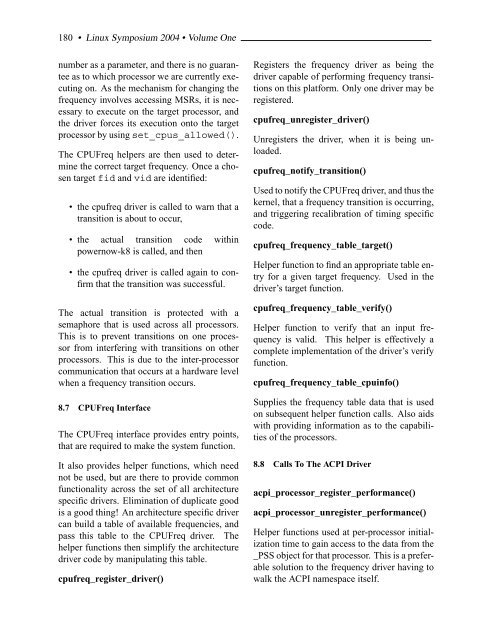You also want an ePaper? Increase the reach of your titles
YUMPU automatically turns print PDFs into web optimized ePapers that Google loves.
180 • <strong>Linux</strong> Symposium 2004 • Volume <strong>One</strong><br />
number as a parameter, and there is no guarantee<br />
as to which processor we are currently executing<br />
on. As the mechanism for changing the<br />
frequency involves accessing MSRs, it is necessary<br />
to execute on the target processor, and<br />
the driver forces its execution onto the target<br />
processor by using set_cpus_allowed().<br />
<strong>The</strong> CPUFreq helpers are then used to determine<br />
the correct target frequency. Once a chosen<br />
target fid and vid are identified:<br />
• the cpufreq driver is called to warn that a<br />
transition is about to occur,<br />
• the actual transition code within<br />
powernow-k8 is called, and then<br />
• the cpufreq driver is called again to confirm<br />
that the transition was successful.<br />
<strong>The</strong> actual transition is protected with a<br />
semaphore that is used across all processors.<br />
This is to prevent transitions on one processor<br />
from interfering with transitions on other<br />
processors. This is due to the inter-processor<br />
communication that occurs at a hardware level<br />
when a frequency transition occurs.<br />
8.7 CPUFreq Interface<br />
<strong>The</strong> CPUFreq interface provides entry points,<br />
that are required to make the system function.<br />
It also provides helper functions, which need<br />
not be used, but are there to provide common<br />
functionality across the set of all architecture<br />
specific drivers. Elimination of duplicate good<br />
is a good thing! An architecture specific driver<br />
can build a table of available frequencies, and<br />
pass this table to the CPUFreq driver. <strong>The</strong><br />
helper functions then simplify the architecture<br />
driver code by manipulating this table.<br />
cpufreq_register_driver()<br />
Registers the frequency driver as being the<br />
driver capable of performing frequency transitions<br />
on this platform. Only one driver may be<br />
registered.<br />
cpufreq_unregister_driver()<br />
Unregisters the driver, when it is being unloaded.<br />
cpufreq_notify_transition()<br />
Used to notify the CPUFreq driver, and thus the<br />
kernel, that a frequency transition is occurring,<br />
and triggering recalibration of timing specific<br />
code.<br />
cpufreq_frequency_table_target()<br />
Helper function to find an appropriate table entry<br />
for a given target frequency. Used in the<br />
driver’s target function.<br />
cpufreq_frequency_table_verify()<br />
Helper function to verify that an input frequency<br />
is valid. This helper is effectively a<br />
complete implementation of the driver’s verify<br />
function.<br />
cpufreq_frequency_table_cpuinfo()<br />
Supplies the frequency table data that is used<br />
on subsequent helper function calls. Also aids<br />
with providing information as to the capabilities<br />
of the processors.<br />
8.8 Calls To <strong>The</strong> ACPI Driver<br />
acpi_processor_register_performance()<br />
acpi_processor_unregister_performance()<br />
Helper functions used at per-processor initialization<br />
time to gain access to the data from the<br />
_PSS object for that processor. This is a preferable<br />
solution to the frequency driver having to<br />
walk the ACPI namespace itself.

















